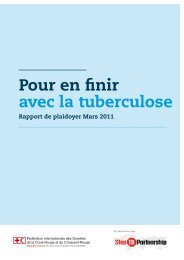2005 and Challenges for 2006 - 2015 [.pdf] - Stop TB Partnership
2005 and Challenges for 2006 - 2015 [.pdf] - Stop TB Partnership
2005 and Challenges for 2006 - 2015 [.pdf] - Stop TB Partnership
Create successful ePaper yourself
Turn your PDF publications into a flip-book with our unique Google optimized e-Paper software.
THE GLOBAL PLAN TO STOP <strong>TB</strong> <strong>2006</strong>-<strong>2015</strong>:<br />
PART I<br />
Strategic directions<br />
1. ACHIEVEMENTS IN 2000–<strong>2005</strong> AND<br />
CHALLENGES FOR <strong>2006</strong>-<strong>2015</strong><br />
1.1 A thriving <strong>Partnership</strong><br />
The <strong>Stop</strong> <strong>TB</strong> <strong>Partnership</strong> has built an effective network to promote<br />
<strong>and</strong> coordinate the contributions of a wide <strong>and</strong> increasing range<br />
of stakeholders. A thriving <strong>Partnership</strong>, its global membership<br />
grew to over 400 organizations in <strong>2005</strong>. Regional <strong>and</strong> national<br />
<strong>Stop</strong> <strong>TB</strong> partnerships are now being <strong>for</strong>med to support longterm<br />
expansion of DOTS at country level.<br />
See Figure 1: Structure of the <strong>Stop</strong> <strong>TB</strong> <strong>Partnership</strong><br />
The <strong>Partnership</strong> is governed by a Partners’ Forum <strong>and</strong> a<br />
Coordinating Board, supported by a strong Secretariat housed<br />
in WHO. Large, lively <strong>and</strong> successful Partners’ Forum meetings<br />
were held in 2001 <strong>and</strong> 2004 to set the strategic direction <strong>and</strong><br />
ensure consensus on priorities <strong>for</strong> action. The <strong>Partnership</strong><br />
Coordinating Board meets every six months to provide<br />
leadership <strong>and</strong> direction, <strong>and</strong> to monitor the implementation of<br />
policies, plans <strong>and</strong> activities of the <strong>Partnership</strong>.<br />
The <strong>Partnership</strong> has structured its seven working groups to<br />
address directly the major challenges of <strong>TB</strong> today:<br />
• DOTS Expansion Working Group, with individual subgroups<br />
on laboratory capacity strengthening, public-private mix,<br />
childhood <strong>TB</strong>, <strong>and</strong> poverty <strong>and</strong> <strong>TB</strong>;<br />
• Working Group on DOTS-Plus <strong>for</strong> Multidrug-resistant <strong>TB</strong>;<br />
• <strong>TB</strong>/HIV Working Group;<br />
• Working Group on New <strong>TB</strong> Diagnostics;<br />
• Working Group on New <strong>TB</strong> Drugs;<br />
• Working Group on New <strong>TB</strong> Vaccines;<br />
• Advocacy, Communications <strong>and</strong> Social Mobilization Working<br />
Group.<br />
One of the great strengths of the <strong>Stop</strong> <strong>TB</strong> <strong>Partnership</strong> is that it<br />
brings together the <strong>TB</strong> research community with those engaged<br />
in programme implementation. As this Plan makes clear, their<br />
effective collaboration is critical to the rapid development <strong>and</strong><br />
deployment of sorely needed new tools.<br />
Under the <strong>Partnership</strong>’s basic framework, the working groups<br />
are the primary means of coordinating activities m<strong>and</strong>ated<br />
by the Board. The plans of the working groups <strong>and</strong> the<br />
Secretariat provide the basis <strong>for</strong> action, resource allocation <strong>and</strong><br />
accountability within the Global Plan <strong>2006</strong>–<strong>2015</strong>.<br />
1.2 Achievements in global <strong>TB</strong> control<br />
since 2000<br />
The <strong>Partnership</strong> will publish a full report of achievements within<br />
its first Global Plan to <strong>Stop</strong> <strong>TB</strong> 2001–<strong>2005</strong> after the end of the<br />
plan period. The following are a few highlights to date.<br />
Evaluation: As confirmed by an independent external evaluation<br />
in 2003, the <strong>Stop</strong> <strong>TB</strong> <strong>Partnership</strong> has established itself, in a very<br />
short period of time, as a successful public-private partnership<br />
<strong>for</strong> health.<br />
29
PART I: STRATEGIC DIRECTIONS<br />
FIGURE 1: STRUCTURE OF THE STOP <strong>TB</strong> PARTNERSHIP<br />
GLOBAL PARTNER'S FORUM<br />
Global <strong>TB</strong><br />
Drug Facility<br />
Coordinating<br />
Board<br />
<strong>Partnership</strong><br />
Secretariat<br />
WHO Technical<br />
Advisory Group<br />
DOTS Expansion<br />
<strong>TB</strong>-HIV<br />
DOTS-Plus<br />
MDR-<strong>TB</strong><br />
New <strong>TB</strong><br />
Vaccines<br />
New <strong>TB</strong><br />
Diagnostics<br />
New <strong>TB</strong><br />
Drugs<br />
Advocacy,<br />
communication<br />
<strong>and</strong> Social<br />
Mobilization<br />
ADVISORY GROUP ON RESOURCE MOBILISATION<br />
Coordination <strong>and</strong> planning: The <strong>Partnership</strong>’s Global Plan<br />
to <strong>Stop</strong> <strong>TB</strong> <strong>for</strong> 2001–<strong>2005</strong> provided the first integrated plan<br />
of action <strong>for</strong> implementation <strong>and</strong> research, <strong>and</strong> identified the<br />
funding required. Most of the planned investment was <strong>for</strong><br />
implementation of the DOTS strategy in the 22 priority countries<br />
with the largest number of <strong>TB</strong> cases (listed in Annex 2). The DOTS<br />
Expansion Working Group, in collaboration with the DOTS-Plus<br />
<strong>and</strong> <strong>TB</strong>/HIV Working Groups, coordinated implementation of<br />
the DOTS strategy <strong>and</strong> its adaptations. At country level, the<br />
22 high-burden countries established interagency coordination<br />
committees <strong>and</strong> implemented DOTS expansion plans.<br />
DOTS Expansion: DOTS is an internationally recognized<br />
strategy <strong>for</strong> delivering the basics of <strong>TB</strong> case-finding <strong>and</strong> cure.<br />
It is not simply a clinical approach to patients, but rather a<br />
management strategy <strong>for</strong> public health systems, including<br />
political commitment as well as case-detection through qualityassured<br />
bacteriology, short-course chemotherapy, ensuring<br />
patient adherence to treatment, adequate drug supply, <strong>and</strong><br />
sound reporting <strong>and</strong> recording systems. The first Global Plan<br />
2001-<strong>2005</strong> estimated that US$5 billion would be needed <strong>for</strong><br />
DOTS expansion. In practice, about US$5 billion was mobilized<br />
<strong>and</strong> spent effectively. By the end of 2003, over three-quarters<br />
of the world’s population lived in countries that had officially<br />
adopted DOTS. The proportion is expected to reach over 90%<br />
by the end of <strong>2005</strong>.<br />
See Figure 2. Effect of the Global DOTS Expansion Plan (GDEP)<br />
on the case detection rate<br />
In 2000, the <strong>Partnership</strong> adopted targets <strong>for</strong> <strong>2005</strong> set by the<br />
World Health Assembly, of detecting 70% of new smear-positive<br />
cases, <strong>and</strong> successfully treating 85% of those detected. In<br />
the absence of HIV, achieving these targets should lead to a<br />
substantial decrease in the <strong>TB</strong> prevalence rate, <strong>and</strong> an annual<br />
decrease in the incidence rate of about 5–10% 1 . This expected<br />
epidemiological impact has been demonstrated recently in, <strong>for</strong><br />
example, Peru <strong>and</strong> the areas of China that are implementing the<br />
DOTS strategy (comprising half the country).<br />
As illustrated in Figure 2, <strong>TB</strong> case detection under the DOTS<br />
strategy has accelerated over the past few years with<br />
implementation of the Global DOTS Expansion Plan. <strong>TB</strong> cases<br />
notified under DOTS programmes in 2003 represented 45% of<br />
estimated new smear-positive <strong>TB</strong> cases. Continuation of the<br />
upward trend would result in a case-detection rate of 60% by<br />
<strong>2005</strong> – short of the 70% target but a significant improvement<br />
since the launch of the first Global Plan to <strong>Stop</strong> <strong>TB</strong>, when the<br />
case-detection rate was 27%. The treatment success rate in the<br />
2002 DOTS cohort was 82% on average, on track to achieve<br />
the <strong>2005</strong> target of 85% on time. However, the treatment success<br />
rate remains substantially below the average in the WHO regions<br />
of Africa (73%) <strong>and</strong> Europe (76%).<br />
Increased technical support: With the significant influx of<br />
resources <strong>for</strong> <strong>TB</strong> control from the Global Fund to Fight AIDS,<br />
Tuberculosis <strong>and</strong> Malaria (GFATM), banks <strong>and</strong> bilateral donors,<br />
new coordinated mechanisms to provide technical cooperation<br />
have been created. They focus on increasing the efficiency<br />
of support, as well as building the cadre of human resources<br />
capable of providing technical cooperation, <strong>and</strong> promoting<br />
exchange of expertise among countries with a high burden of<br />
<strong>TB</strong>. The aim is to improve technical capacity in order to make<br />
most effective use of the new funding, <strong>and</strong> so accelerate DOTS<br />
expansion towards the <strong>2005</strong> targets.<br />
Drug supply: The Global Drug Facility (GDF), established by the<br />
<strong>Partnership</strong>, has provided treatment <strong>for</strong> more than 4.5 million<br />
patients, at the same time as catalysing a worldwide improvement<br />
in the quality of <strong>TB</strong> drugs, <strong>and</strong> a reduction in their cost. In addition,<br />
the Green Light Committee (GLC) promotes access to, <strong>and</strong><br />
rational use of, second-line drugs with activity against multidrugresistant<br />
<strong>TB</strong>. It has secured price reductions of 95% <strong>for</strong> some<br />
second-line drugs. To help prevent misuse of these drugs, the<br />
GFATM selected the GLC as its mechanism <strong>for</strong> procurement of<br />
second-line drugs <strong>and</strong> monitoring of approved projects. The GDF<br />
<strong>and</strong> the GLC are merging in a phased programme.<br />
30
PART I: STRATEGIC DIRECTIONS<br />
FIGURE 2: EFFECT OF THE GLOBAL DOTS EXPANSION PLAN ON THE CASE DETECTION RATE<br />
80<br />
Case detection rate, smear-positive cases (%)<br />
70<br />
60<br />
50<br />
40<br />
30<br />
20<br />
10<br />
WHO target: 70%<br />
DOTS<br />
starts<br />
Acceleration<br />
Scale<br />
Implementation<br />
Preparation<br />
GDEP*<br />
Predicted trend if<br />
average increase<br />
1995-2000 had<br />
continued<br />
0<br />
1990<br />
1995<br />
2000<br />
<strong>2005</strong><br />
2010<br />
<strong>2015</strong><br />
Note: The <strong>2005</strong> value is a prediction based on current activities <strong>and</strong> trends.<br />
* Global DOTS Expansion Plan<br />
Multidrug-resistant <strong>TB</strong>: Multidrug-resistant <strong>TB</strong> (MDR-<strong>TB</strong>) is<br />
<strong>for</strong>mally defined as resistance to isoniazid <strong>and</strong> rifampicin, the two<br />
most effective anti-<strong>TB</strong> drugs. Projects have demonstrated that<br />
management of MDR-<strong>TB</strong> is feasible <strong>and</strong> effective in resourcelimited<br />
settings. As a result of additional funding <strong>for</strong> control<br />
of MDR-<strong>TB</strong>, there has been a rapid increase in the number of<br />
countries implementing DOTS-Plus. By July <strong>2005</strong>, 36 DOTS-<br />
Plus pilot projects treating more than 10 000 patients with MDR-<br />
<strong>TB</strong> had been established in 27 countries. 2<br />
<strong>TB</strong>/HIV: The <strong>TB</strong>/HIV Working Group has published a core set of<br />
strategy <strong>and</strong> policy guidance documents to assist countries in<br />
implementing <strong>and</strong> monitoring collaborative <strong>TB</strong>/HIV activities.3<br />
There has until now been limited collaboration between <strong>TB</strong><br />
<strong>and</strong> HIV/AIDS control programmes, but many are beginning<br />
to adopt elements of the WHO interim policy <strong>for</strong> collaborative<br />
<strong>TB</strong>/HIV activities. By 2003, 29 of the 41 countries with the<br />
highest prevalence of <strong>TB</strong>/HIV had a national policy on <strong>TB</strong>/HIV<br />
collaboration <strong>and</strong> 16 had a national <strong>TB</strong>/HIV coordinating body.<br />
New diagnostic tests: The creation of the Working Group on<br />
New <strong>TB</strong> Diagnostics in 2001 established a plat<strong>for</strong>m <strong>for</strong> focused<br />
development of new diagnostic products. Through the UNICEF/<br />
UNDP/World Bank/WHO Special Programme <strong>for</strong> Research<br />
<strong>and</strong> Training in Tropical Diseases (TDR) <strong>and</strong> the Foundation<br />
<strong>for</strong> Innovative New Diagnostics (FIND), promising technologies<br />
have been screened, <strong>and</strong> an exciting series of new product<br />
developments initiated, supported, <strong>and</strong>/or subjected to field<br />
trials. Currently there are 15 new diagnostics under development.<br />
At the same time, tools such as sample <strong>and</strong> strain banks have<br />
been developed to assist researchers.<br />
New drugs: With support from the Working Group on New <strong>TB</strong><br />
Drugs <strong>and</strong> the Global Alliance <strong>for</strong> <strong>TB</strong> Drug Development, there is<br />
now a coordinated portfolio of promising new compounds, some<br />
of which have the potential to become the cornerstone drugs<br />
<strong>for</strong> <strong>TB</strong> control <strong>and</strong> even contribute to the elimination of <strong>TB</strong> in<br />
the future. There are 27 drugs in the pipeline, with research <strong>and</strong><br />
development activity in virtually all stages of <strong>TB</strong> drug discovery<br />
<strong>and</strong> development – from early discovery projects through to<br />
clinical testing. This remarkable achievement is the result of<br />
critical collaborations between public <strong>and</strong> private partners that<br />
have leveraged the scientific <strong>and</strong> clinical knowledge of industry,<br />
the public health sector, <strong>and</strong> academic laboratories throughout<br />
the world.<br />
New vaccines: In 2000, the Working Group on New <strong>TB</strong> Vaccines<br />
took note of the historic opportunities <strong>for</strong> development of new<br />
<strong>TB</strong> vaccines that resulted from the availability of techniques<br />
<strong>for</strong> the genetic manipulation of mycobacteria, <strong>and</strong> completion<br />
of the genome sequence of M. tuberculosis. By <strong>2005</strong>, five new<br />
vaccine c<strong>and</strong>idates were in phase I trials, <strong>and</strong> three more were<br />
due to start shortly. Important factors in success include major<br />
strategic investments by donors <strong>and</strong> foundations to support the<br />
Aeras Global <strong>TB</strong> Vaccine Foundation.<br />
Advocacy <strong>and</strong> funding: The profile of <strong>TB</strong> has been raised at<br />
global level <strong>and</strong> in many countries with dedicated advocacy <strong>and</strong><br />
communications activity to embed <strong>TB</strong> in the political agenda.<br />
Heightened political <strong>and</strong> funding support <strong>for</strong> the activities<br />
outlined in the first Global Plan to <strong>Stop</strong> <strong>TB</strong> (2000–<strong>2005</strong>) has<br />
assisted progress against <strong>TB</strong> worldwide. Expressions of support<br />
<strong>for</strong> <strong>TB</strong> control targets <strong>and</strong> <strong>for</strong> commensurate funding have been<br />
included in G8 communiqués (2000 <strong>and</strong> <strong>2005</strong>), a World Health<br />
Assembly resolution (<strong>2005</strong>), the declaration of a <strong>TB</strong> emergency<br />
by the WHO Regional Committee <strong>for</strong> Africa, the Commission<br />
<strong>for</strong> Macroeconomics <strong>and</strong> Health (2001), <strong>and</strong> in high-level<br />
statements by Nelson M<strong>and</strong>ela, the African Union, <strong>and</strong> the<br />
31
PART I: STRATEGIC DIRECTIONS<br />
Commission <strong>for</strong> Africa. There has been substantial improvement<br />
in funding available <strong>for</strong> <strong>TB</strong> control since 2002. The Global Fund<br />
to Fight AIDS, Tuberculosis <strong>and</strong> Malaria now plays a major role<br />
in financing <strong>TB</strong> control, contributing more than one third of the<br />
budget in a number of high-burden countries.<br />
1.3 <strong>TB</strong> today 4<br />
There are eight <strong>TB</strong> epidemiological regions (Figure 3) 5 . The<br />
countries in the region comprising the Established Market<br />
Economies (EME) <strong>and</strong> Central Europe have similarly high per<br />
capita income levels <strong>and</strong> low tuberculosis incidence rates. The<br />
Plan there<strong>for</strong>e focuses mainly on the other seven regions: African<br />
countries with high HIV prevalence (AFR High HIV); African<br />
countries with low HIV prevalence (AFR Low HIV); the American<br />
Region (AMR) – Latin America Countries (LAC); Eastern Europe<br />
Region (EEUR); Eastern Mediterranean Region (EMR); South-<br />
East Asia Region (SEAR); <strong>and</strong> the Western Pacific Region (WPR).<br />
It nevertheless remains important <strong>for</strong> the Established Market<br />
Economies <strong>and</strong> Central Europe to maintain <strong>and</strong> strengthen their<br />
<strong>TB</strong> control programmes.<br />
In 2003, there were 8.8 million new cases of <strong>TB</strong>, of which 3.9 million<br />
were smear-positive; 674 000 of the patients were coinfected with<br />
HIV. There were a total of 15.4 million cases, of which 6.9 million<br />
were smear-positive. An estimated 1.7 million people died from<br />
<strong>TB</strong>, including 229 000 people coinfected with HIV.<br />
See Figure 4: Estimated <strong>TB</strong> incidence rates, 2003<br />
While the <strong>TB</strong> incidence rate is decreasing or stable in all regions<br />
except Africa, the latest available figures (2003) show that the<br />
global incidence rate grew by 1% from 2002. This is a slower<br />
rate of growth than in previous years, but is still alarming. The<br />
continuing increase is largely due to the increasing rate in<br />
Africa, fuelled by the HIV epidemic <strong>and</strong> by the adverse social<br />
<strong>and</strong> economic situation. In Eastern Europe 6 , the incidence<br />
rate increased during the 1990s, which was a period of rapidly<br />
increasing inequity <strong>and</strong> deteriorating public health systems. It<br />
peaked around 2001 <strong>and</strong> has since fallen slightly. The rise in<br />
global incidence is slowing because the HIV epidemic in Africa<br />
is slowing.<br />
In terms of the global distribution of the burden of <strong>TB</strong>, in 2003<br />
the South-East Asian region notified 35% of all cases, the<br />
African region 24%, <strong>and</strong> the Western Pacific region 22%. The<br />
22 high-burden countries account <strong>for</strong> approximately 80% of<br />
all estimated new <strong>TB</strong> cases each year. China <strong>and</strong> India alone<br />
account <strong>for</strong> 35%. India, the country with the greatest burden of<br />
<strong>TB</strong>, is also the country where the most dramatic advances are<br />
being made in DOTS expansion. Thanks to a massive recent<br />
scale-up, China expects to achieve nationwide DOTS coverage<br />
in <strong>2005</strong>.<br />
Although the global <strong>TB</strong> incidence rate is still slowly rising,<br />
prevalence <strong>and</strong> death rates are falling. WHO calculates that the<br />
expansion of the WHO-recommended DOTS strategy between<br />
1990 <strong>and</strong> 2003 led to a fall in the global <strong>TB</strong> prevalence rate<br />
from 309 to 245 per 100 000 (including HIV-positive patients),<br />
including a 5% fall between 2002 <strong>and</strong> 2003.<br />
See Figure 5: Estimated prevalence of HIV infection in <strong>TB</strong> cases,<br />
2003<br />
FIGURE 3: THE EIGHT <strong>TB</strong> EPIDEMIOLOGICAL REGIONS<br />
AFR High HIV<br />
AFR Low HIV<br />
EEUR<br />
EMR<br />
EME <strong>and</strong> Central Europe<br />
LAC<br />
SEAR<br />
WPR<br />
No estimate<br />
32
PART I: STRATEGIC DIRECTIONS<br />
FIGURE 4: ESTIMATED <strong>TB</strong> INCIDENCE RATES, 2003<br />
Rates per 100.000, all <strong>for</strong>m of <strong>TB</strong><br />
0 - 24<br />
25 - 49<br />
50 - 99<br />
100 - 299<br />
300 or more<br />
No estimate<br />
FIGURE 5: ESTIMATED PREVALENCE OF HIV INFECTION IN <strong>TB</strong> CASES, 2003<br />
HIV prevalence in <strong>TB</strong> cases, 15-49 years (%)<br />
0 - 4<br />
5 - 19<br />
20 - 49<br />
50 or more<br />
No estimate<br />
33
PART I: STRATEGIC DIRECTIONS<br />
The global death rate from <strong>TB</strong> peaked during the 1990s. Between<br />
2002 <strong>and</strong> 2003, it fell by 2.5% overall, <strong>and</strong> by 3.5% among<br />
HIV-negative patients. If not <strong>for</strong> the strongly adverse trends in<br />
Africa, prevalence <strong>and</strong> death rates would be falling more quickly<br />
worldwide.<br />
Several regions of the world are experiencing severe epidemics<br />
of multidrug-resistant <strong>TB</strong> that threaten <strong>TB</strong> control <strong>and</strong> translate<br />
into low cure rates. New estimates suggest that there are about<br />
half a million MDR-<strong>TB</strong> cases each year, including new <strong>and</strong><br />
previously treated cases. The highest prevalences of MDR-<strong>TB</strong><br />
have been observed in countries in Eastern Europe <strong>and</strong> some<br />
provinces of China. However, most regions have reported one<br />
or more countries with an MDR-<strong>TB</strong> prevalence of 5–6% among<br />
new cases. Drug resistance is also more severe in Eastern<br />
Europe than in other regions. For example, 50% of MDR-<strong>TB</strong><br />
cases detected in these countries are resistant to all four firstline<br />
drugs, compared with only 12% in the rest of the world.<br />
While surveillance is not yet st<strong>and</strong>ardized, many countries in<br />
Eastern Europe also report high levels of resistance to secondline<br />
drugs.<br />
1.4 <strong>Challenges</strong> ahead<br />
Despite the achievements of recent years, there are still<br />
tremendous barriers to ensuring equitable access to high quality<br />
DOTS services <strong>and</strong> achieving <strong>TB</strong> control targets:<br />
The rapid scale-up of DOTS coverage has put high dem<strong>and</strong><br />
on programme management, supervision <strong>and</strong> quality control.<br />
In many countries, it is difficult to meet these dem<strong>and</strong>s because<br />
of generally weak health systems, a lack of human resources,<br />
limited funds <strong>and</strong>, ultimately, insufficient political commitment.<br />
This situation is exacerbated because governments are also<br />
rapidly scaling up interventions against other health priorities,<br />
such as HIV/AIDS <strong>and</strong> malaria. Planning <strong>and</strong> implementing DOTS<br />
programmes in settings with high rates of HIV or MDR-<strong>TB</strong> require<br />
skills <strong>and</strong> resources <strong>for</strong> interagency collaboration, programme<br />
management, supervision, monitoring <strong>and</strong> evaluation.<br />
New tools remain urgently needed to increase the speed<br />
<strong>and</strong> precision of <strong>TB</strong> diagnosis, as well as to improve the<br />
effectiveness of treatment <strong>and</strong> reduce its duration. Progress has<br />
been impressive, but large-scale investment will continue to be<br />
necessary to make actual <strong>and</strong> potential new tools available <strong>for</strong><br />
use.<br />
HIV continues to present one of the greatest challenges to<br />
ef<strong>for</strong>ts to achieve the global <strong>TB</strong> control targets. In 2003, national<br />
<strong>TB</strong> programmes reported that few <strong>TB</strong> patients were being tested<br />
<strong>for</strong> HIV; still fewer were assessed <strong>for</strong> antiretroviral therapy (ART),<br />
<strong>and</strong> a very small fraction began ART. Even in Brazil, where ART<br />
is provided free of charge in the public sector, in 2003 only half<br />
of the notified <strong>TB</strong> patients were reported to have been tested<br />
<strong>for</strong> HIV.<br />
Multidrug-resistant <strong>TB</strong> threatens the potential salutary<br />
impact of DOTS programmes. Although progress in widespread<br />
DOTS implementation will help prevent the further emergence of<br />
drug-resistance, expansion of effective DOTS-Plus programmes<br />
is vital to stem the contribution of drug-resistant cases to the<br />
overall <strong>TB</strong> epidemic. Too few countries have national policies <strong>for</strong><br />
the diagnosis <strong>and</strong> treatment of MDR-<strong>TB</strong>. In some of those that<br />
do, treatment commonly fails to meet acceptable st<strong>and</strong>ards.<br />
Access to good quality services is still inequitable in many<br />
settings. People in remote rural areas have serious difficulty in<br />
obtaining services unless they are highly decentralized. Poor<br />
people in general often have problems accessing services<br />
because of high direct <strong>and</strong> indirect costs. Many are caught in<br />
a disease–poverty trap, because of their high expenditure on<br />
health care. Reaching the poor with af<strong>for</strong>dable, quality services<br />
is a problem not only <strong>for</strong> remote rural populations, but also <strong>for</strong><br />
the growing population of urban poor – the slum dwellers, the<br />
homeless, <strong>and</strong> the migrants. Developing appropriate pro-poor<br />
strategies will require a broad approach involving communities,<br />
civil society, nongovernmental organizations, <strong>and</strong> all relevant<br />
health care providers.<br />
There is still limited awareness of <strong>TB</strong>. Stigma, <strong>and</strong> poor<br />
knowledge about what types of <strong>TB</strong> services are available <strong>and</strong><br />
effective, contribute to underuse of services <strong>and</strong> to the social<br />
costs of <strong>TB</strong>. Where quality services are available <strong>and</strong> truly<br />
accessible, it is essential to devise communication strategies to<br />
raise awareness of <strong>TB</strong> <strong>and</strong> the available treatment services, <strong>and</strong><br />
to counter stigma. Limited awareness of <strong>TB</strong> in countries with low<br />
<strong>TB</strong> incidence is a barrier to raising donor funds <strong>for</strong> <strong>TB</strong> control in<br />
countries with high or medium <strong>TB</strong> incidence.<br />
In most countries, large parts of the health system are still<br />
not involved in implementing DOTS. Many public <strong>and</strong> private<br />
health care providers do not use evidence-based approaches<br />
to <strong>TB</strong> diagnosis <strong>and</strong> treatment. This leads to overdiagnosis,<br />
missed or delayed diagnosis, poor treatment results, drug<br />
resistance, <strong>and</strong> wasted resources (including patients’ own<br />
resources when they have to make out-of-pocket payments). In<br />
the future, the new International st<strong>and</strong>ards <strong>for</strong> tuberculosis care<br />
should be implemented by all health care providers involved in<br />
<strong>TB</strong> diagnosis <strong>and</strong> treatment. 7<br />
Sustained funding remains uncertain. Although the funding<br />
available <strong>for</strong> global <strong>TB</strong> control has increased in recent years,<br />
it will be a continuing challenge <strong>for</strong> the <strong>Partnership</strong> to help<br />
mobilize sufficient resources to reach the targets outlined in<br />
this Global Plan. Existing gaps in funding <strong>and</strong> uncertainty about<br />
future financing impede planning <strong>and</strong> implementation <strong>for</strong> both<br />
treatment <strong>and</strong> research. For example, recent data indicated that<br />
funding fell about 20% short of total needs <strong>for</strong> DOTS expansion<br />
in 2004 <strong>and</strong> <strong>2005</strong>. A <strong>2005</strong> World Health Assembly resolution<br />
called <strong>for</strong> sustainable financing <strong>for</strong> <strong>TB</strong> control. 8<br />
34


![2005 and Challenges for 2006 - 2015 [.pdf] - Stop TB Partnership](https://img.yumpu.com/26788674/1/500x640/2005-and-challenges-for-2006-2015-pdf-stop-tb-partnership.jpg)
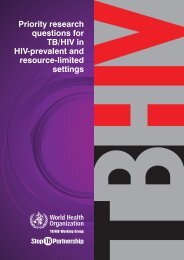
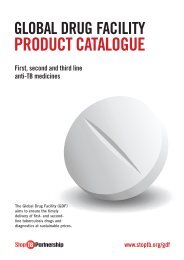
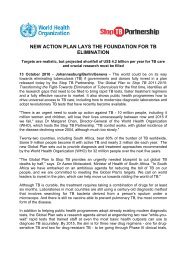
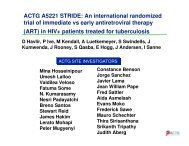
![Global Drug Facility Annual Report 2011 [.pdf] - Stop TB Partnership](https://img.yumpu.com/26788745/1/184x260/global-drug-facility-annual-report-2011-pdf-stop-tb-partnership.jpg?quality=85)

![Concept note on national stop TB partnership [.pdf]](https://img.yumpu.com/26788741/1/184x260/concept-note-on-national-stop-tb-partnership-pdf.jpg?quality=85)
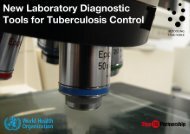

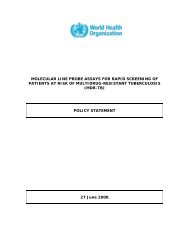
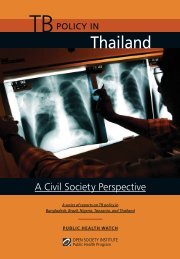
![Brochure (French) [.pdf] - Stop TB Partnership](https://img.yumpu.com/17234792/1/190x91/brochure-french-pdf-stop-tb-partnership.jpg?quality=85)

